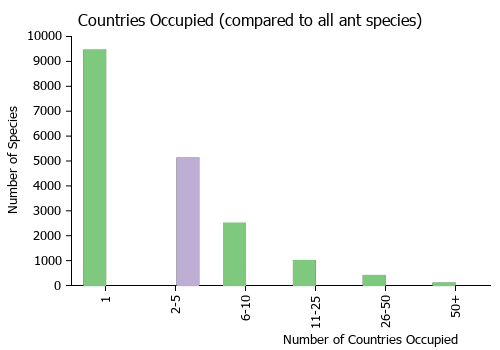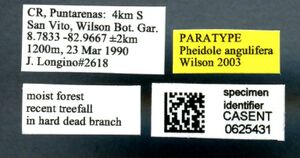Pheidole angulifera
| Pheidole angulifera | |
|---|---|

| |
| Scientific classification | |
| Kingdom: | Animalia |
| Phylum: | Arthropoda |
| Class: | Insecta |
| Order: | Hymenoptera |
| Family: | Formicidae |
| Subfamily: | Myrmicinae |
| Tribe: | Attini |
| Genus: | Pheidole |
| Species: | P. angulifera |
| Binomial name | |
| Pheidole angulifera Wilson, 2003 | |
Occurs in wet montane forests; the type colony was found nesting in a hard dead branch (Longino 1997).
Identification
See the description in the nomenclature section.
Keys including this Species
Distribution
Southern Pacific highlands of Costa Rica (Longino 1997).
Latitudinal Distribution Pattern
Latitudinal Range: 9.15° to 9.15°.
| North Temperate |
North Subtropical |
Tropical | South Subtropical |
South Temperate |
- Source: AntMaps
Distribution based on Regional Taxon Lists
Neotropical Region: Colombia, Costa Rica (type locality).
Distribution based on AntMaps
Distribution based on AntWeb specimens
Check data from AntWeb
Countries Occupied
| Number of countries occupied by this species based on AntWiki Regional Taxon Lists. In general, fewer countries occupied indicates a narrower range, while more countries indicates a more widespread species. |

|
Estimated Abundance
| Relative abundance based on number of AntMaps records per species (this species within the purple bar). Fewer records (to the left) indicates a less abundant/encountered species while more records (to the right) indicates more abundant/encountered species. |

|
Biology
Castes
Worker
Minor
Images from AntWeb
    
| |
| Paratype Pheidole angulifera. Worker. Specimen code casent0625430. Photographer Jeremy Pilllow, uploaded by University of Utah. | Owned by JTLC. |
Major
Images from AntWeb
    
| |
| Worker (major/soldier). Specimen code inbiocri001281572. Photographer J. Russ, uploaded by California Academy of Sciences. | Owned by JTLC. |
Images from AntWeb

| |
| Holotype major Pheidole angulifera. Worker (major/soldier). Specimen code inbiocri001281571. Photographer Jeremy Pilllow, uploaded by University of Utah. | Owned by JTLC. |
Queen
Images from AntWeb
    
| |
| Paratype Pheidole angulifera. Queen (alate/dealate). Specimen code casent0625431. Photographer Jeremy Pilllow, uploaded by University of Utah. | Owned by JTLC. |
Nomenclature
The following information is derived from Barry Bolton's Online Catalogue of the Ants of the World.
- angulifera. Pheidole angulifera Wilson, 2003: 371, figs. (s.w.) COSTA RICA.
Unless otherwise noted the text for the remainder of this section is reported from the publication that includes the original description.
Description
A medium-sized, bicolorous member of the flavens group whose major is distinguished by the prominent “sharkfin” shape of the pronotal humerus in dorsal-oblique view. In this respect it resembles the major of Pheidole schmalzi of South America but is distinct in the way the angles extend past the lower humeral margins in dorsal view, and in the wider, nearly perfectly semicircular shape of the occipital border. The minor has a much less prominent humeral profile in dorsal-oblique view than that of schmalzi, and the carinulae on the dorsal surface of the head do not extend beyond the eye.
Compare also with Pheidole arhuaca, Pheidole boliviana, Pheidole caulicola, Pheidole chalca, Pheidole nitidicollis, Pheidole crinita, Pheidole flavifrons, Pheidole mincana, Pheidole sagana, Pheidole tambopatae and Pheidole tysoni.
MEASUREMENTS (mm) Holotype major: HW 0.88, HL 0.92, SL 0.42, EL 0.10, PW 0.46. Paratype minor: HW 0.48, HL 0.54, SL 0.40, EL 0.06, PW 0.34.
COLOR Major: yellowish brown; head faintly bicolorous, with head capsule anterior to eye a slightly contrasting dark yellow.
Minor: head light brown; gena a slightly contrasting dark yellow; anterior half of mesosoma dark yellow and posterior half yellowish brown.
Figure. Upper: holotype, major. Lower: paratype, minor. Scale bars = 1 mm.
Type Material
COSTA RICA: 4 km south of San Vito, Puntarenas, 8°47'N 82°58'W, 1200 m, col. J. T. Longino. Museum of Comparative Zoology
Etymology
L angulifera, angle-bearer, referring to the prominently angulate humerus.
References
- Wilson, E. O. 2003. Pheidole in the New World: A dominant, hyperdiverse ant genus. Harvard University Press, Cambridge, MA. (page 371, fig. major, minor described)
References based on Global Ant Biodiversity Informatics
- Donoso D. A. 2014. Assembly mechanisms shaping tropical litter ant communities. Ecography 37 doi: 10.1111/j.1600-0587.2013.00253.x


